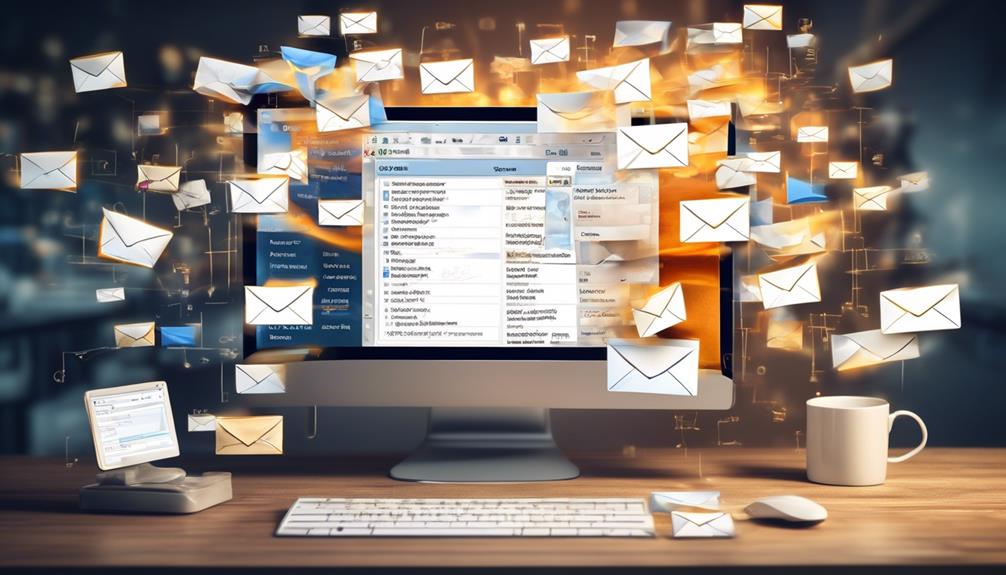As we journey through the complex landscape of technology, we frequently encounter the need for help to solve problems that emerge without warning.
Picture this: you're in the middle of a project, and suddenly, a technical glitch disrupts your workflow. How do you effectively reach out for the support you require to swiftly resolve the matter at hand?
Let's explore the art of composing an email requesting technical assistance, where clarity and precision reign supreme, ensuring a prompt and satisfactory solution.
Key Takeaways
- Craft a specific subject line with keywords related to the problem.
- Set a respectful and concise tone, avoiding blame and expressing empathy.
- Provide clear and concise details, including error messages and troubleshooting steps.
- Ask for specific assistance, outlining the technical problem and needed support.
Crafting an Effective Subject Line
Crafting an effective subject line is crucial when seeking technical support via email for prompt assistance. The subject line is the first thing tech support will see, so it needs to be clear and informative.
When writing a tech support email, it's essential to make the subject line specific to the issue you need help with. Generic subject lines like 'Help Needed' or 'Technical Support Request' may get overlooked or lost in a crowded inbox. Instead, provide a brief summary of your problem in the subject line to help the support team quickly understand the nature of your request.
To ensure your email stands out and receives a timely response, use keywords related to the problem you're experiencing. Including details like the device or software involved can also help the support team prioritize and assign your request effectively.
Setting the Tone Appropriately

To establish a positive and effective communication channel with technical support via email, it's essential to convey a respectful and concise tone in your initial message. When writing your email, let the tone of voice be polite and professional to express empathy towards the support team.
Here are some key points to consider:
- Be Clear and Specific: Clearly explain the issue you're facing and provide any relevant details such as error messages or recent changes.
- Avoid Blaming: Instead of pointing fingers, focus on describing the problem and how it's affecting your work.
- Ask for Help Directly: Clearly state that you require assistance and specify what kind of support you're looking for.
Providing Clear and Concise Details
When detailing technical issues in your email to customer support, ensure you provide clear and concise information regarding the problem encountered. Effective communication is key when asking for help from a technical support team.
In your email, clearly state the issue you're facing, such as error messages or codes, and be specific about the device or software involved. Include any relevant details that could assist the support team in understanding the context of the problem.
It's also beneficial to explain any troubleshooting steps you have already taken to try and resolve the issue. By outlining the problem clearly and providing all necessary details, you make it easier for the support team to assist you promptly and effectively.
Asking for Specific Assistance

When encountering a technical issue, clearly outlining the problem and specifying the assistance needed is essential for efficient support. When writing a customer support email, it's crucial to be specific about the help you require.
Here are some tips to write a request email for Perfect Tech Support:
- Describe the Issue: Provide a detailed explanation of the technical problem you're facing. Be as specific as possible to help the tech support team understand the issue accurately.
- Mention Error Messages: Include any error messages or codes that have appeared on your screen.
- Outline Previous Steps: Briefly mention any troubleshooting steps you have already attempted.
- Specify Software/Hardware: Clearly state the software or hardware components involved in the issue.
Closing Professionally and Polietly
Let's conclude the email with a touch of professionalism and courtesy by incorporating a polite closing phrase and providing our contact information for further communication.
When writing an email asking for technical support, it's crucial to end on a positive note to ensure a good customer experience. Remember to express gratitude with phrases like 'Thank you for your assistance' or 'I appreciate your help.'
Additionally, make it easy for the recipient to reach out to you by including your contact information, such as your email address and phone number.
End the email with a professional closing, such as 'Best regards' or 'Sincerely,' to leave a lasting impression.
Writing a perfect support email involves not only asking for help but also closing it professionally to build strong relationships with the support team. Proofread your email for any errors to avoid misunderstandings, especially with potentially frustrated or angry customers.
Frequently Asked Questions
How Do You Write an Email to Technical Support?
We write emails to technical support by following a structured approach.
It's crucial to use a clear subject line, polite greeting, and concise explanation of the issue.
Including relevant details like error messages helps support agents understand the problem better.
We always wrap up with a polite closing and our contact information for further assistance.
This format ensures effective communication and helps support teams address our concerns promptly.
How Do You Write an Email Asking for Support?
We've got you covered!
When seeking support, it's vital to be clear and concise in your request. Start with a friendly greeting, state your needs clearly, and provide all necessary details.
End with contact info and a thank you. Remember, a little kindness goes a long way in these situations. Trust us, following these steps will make your support request a breeze!
How Do You Write a Professional Email Asking for Something?
When we write a professional email asking for something, it's crucial to be clear and concise.
Start with a polite greeting and clearly state your request. Providing necessary details and ending with a polite closing helps ensure effective communication.
Remember to include your contact information for further dialogue. Keeping the tone friendly yet professional is key to making a good impression.
How Do You Write an Email Explaining a Technical Problem?
When writing an email explaining a technical problem, we ensure clarity by succinctly stating the issue and providing relevant details.
Organizing information with bullet points or numbered lists helps the recipient follow along easily.
We avoid technical jargon and opt for simple language.
Expressing appreciation for the recipient's assistance is crucial.
Starting with an image to set the tone adds sophistication to our message while maintaining a precise, clear, and friendly style.
Can the same format be used for writing an email to ask for technical support as for writing an email to the manager regarding updates?
Yes, the same format can be used for writing an email to ask for technical support as for writing an email to the manager regarding updates. It’s important to be formal and clear in both cases. Here’s a sample email manager update that can work for either situation.
Conclusion
We hope this guide on how to write an email asking for technical support has been helpful.
Remember, being clear and concise is key to getting the assistance you need. Don't hesitate to reach out for help when you need it, as support teams are there to assist you.
By following these tips, you can streamline the process and get the help you need quickly and efficiently.
Thank you for taking the time to read this guide.









